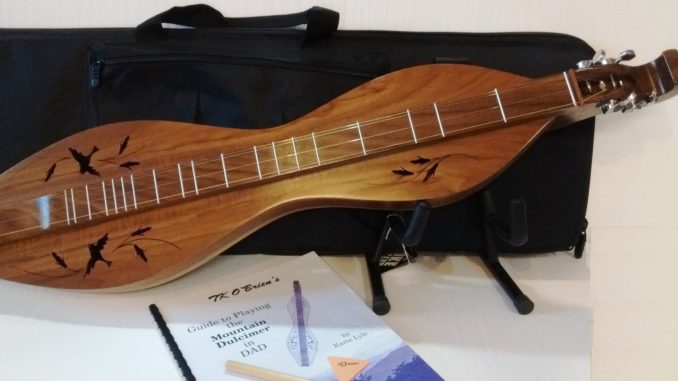
Selecting the tuning for your dulcimer can significantly influence your playing style, the range of music you can perform, and the overall tonality of the instrument. Different tunings offer distinct feels, suggest specific songs, and require learning new scales and chords. In this discussion, we’ll focus on popular tunings for 3, 4, and 5 string mountain dulcimers, excluding hammered dulcimers due to their complexity. Make sure you have the right Dulcimer Strings.

What is the standard tuning for a dulcimer?
The standard tuning for a dulcimer can vary based on the type of dulcimer, but one common tuning for the mountain dulcimer, which is a popular variety, is DAD (from bass to treble strings). This means that the strings are tuned to the following notes:
- D: The bass string (lowest pitch)
- A: The middle string
- D: The treble string (highest pitch)
This tuning provides a diatonic scale and is commonly used for playing folk, traditional, and Appalachian music on the dulcimer. Keep in mind that there are other tunings for dulcimers, and some players may use different tunings depending on their preferences and the music they want to play.
Common Dulcimer Tunings
Many players opt for DAA, DAD, or DGD tunings on their dulcimers, applicable to various string configurations. Let’s explore these tunings:
Major Dulcimer Tunings
- DAA (D Ionian): Commonly used, DAA features the bass string(s) tuned to D, the middle string to A, and the melody string(s) to A, allowing for a major scale.
- DAD (D Mixolydian): In DAD, the bass string(s) is tuned to D, the middle string to A, and the melody string(s) to D, offering a mixolydian scale.
- DGD (Reverse D Ionian): DGD involves tuning the bass string(s) to D, the middle string to G, and the melody string(s) to D. This variation of DAA facilitates playing in the key of G.
Minor Dulcimer Tunings
Exploring minor tunings can add depth to your dulcimer playing:
- DAC (Aeolian): DAC features the bass string(s) tuned to D, the middle string to A, and the melody string(s) to C. This allows for the use of the minor scale starting on the first fret.
- DAG (Dorian): DAG involves tuning the bass string(s) to D, the middle string to A, and the melody string(s) to G. The minor scale begins on the 4th fret.
How to tune a dulcimer
Tuning a dulcimer involves adjusting the tension of the strings to achieve the desired pitches. Here’s a step-by-step guide on how to tune a dulcimer:
Standard Dulcimer Tuning (DAA):
- Bass String (D):
- Pluck the bass string.
- Adjust the tuning peg until the note matches the D below middle C on a piano or the fourth string of a guitar in standard tuning.
- Middle String (A):
- Once the bass string is tuned, locate the A note on the bass string (third fret).
- Pluck the open middle string.
- Adjust the tuning peg until the note matches the A on the bass string.
- Melody String (A):
- With the bass and middle strings in tune, locate the A note on the middle string (third fret).
- Pluck the open melody string.
- Adjust the tuning peg until the note matches the A on the middle string.
Alternate Tunings:
- For DAD or other tunings, follow a similar pattern, adjusting the strings to the desired pitches according to the specific tuning.
Tips:
- Use an electronic tuner for accurate pitch reference.
- If tuning by ear, listen for the beats (wavering sound) between the strings. When the beats slow down or disappear, the strings are in tune.
- Be careful not to over-tension the strings, as this can lead to breakage.
- Regularly check and adjust the tuning, especially if the dulcimer has been exposed to temperature or humidity changes.
Dulcimer Tuning By Ear (Without External Reference):
- DAA Tuning:
- Pluck the open bass string.
- Find the same pitch on the melody string.
- Adjust the melody string until both strings sound the same.
- DAD Tuning:
- Locate the A note on the bass string (second fret).
- Tune the open middle string to the A on the bass string.
- Tune the melody string to the bass string.
- DAC Tuning:
- Follow the pattern of DAD until you reach the melody string.
- Count three frets along the middle string (A -> B -> C).
- Tune the melody string to the C on the middle string.
Remember, practice and experience will enhance your ability to tune by ear. Additionally, using an electronic tuner initially can help train your ear to recognize the correct pitches.
More Dulcimer Articles
Free Dulcimer Tabs
Finger Positions on Mountain Dulcimer
Dulcimer Clubs and Groups USA
What is a Duclimer?
What is a Dulcimer Made From?
Contemporary Dulcimer Makers
What kind of dulcimer does Cyndi Lauper play?
